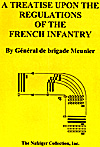
George Nafziger, information compiler extraordinairre of all periods Ottoman to modern, has published a 64-page translation of French general de Brigade Meunier's A Treatise Upon the Regulations of the French Infantry. The actual translation was done by Capt. Gregor MacGregor of the 51st Regiment of Foot in 1809. Nafziger turned the michofiche roll into a published book ($19.95) accessible to all.
Nafziger sandwiched these 38 pages between an introduction to French infantry tactics and the Imperial decree of 18 February 1808 that officially enacted some of the organization changes which Meunier advocated. The introduction offers a solid summary of French doctrine in infantry drill at the battalion level and below, as well as short bios of Meunier and Chef de Brigade Dedon, whose earlier work Meunier used (some say borrowed, others say plaguarized).
The key to this work is that at the time, the French infantry battalion was made up of eight peletons (companies) plus one grenadier peleton (often stripped from the battalion into a converged grenadier battalion). Meunier argues for a six-peleton battalion. In essense, what you're reading is the theoretical work, backed by Meunier's (and presumably Dedon's) experience in the field, of the transition from the old style to the new style battalion structure.
Meunier explains in great detail about which officer or NCO went where and when during various formation changes and maneuvers. You'll find explanations of how columns and lines maneuvered, what guides did during wheels, what occurs during a column of attack by peleton, and so on. One tidbit thing I picked up was that the tallest fellows in a three-rank peleton were placed in the front, with the shortest soldiers in the second rank, and the middling height in the third. Why? To hear orders, as well as keep the explosion of a musket away from ears as much as possible. This positioning allowed firing better than any other combination.
And the real treat -- you might call this the value-added part -- is that Nafziger redraws the original illustrations into computer generated diagrams. Forget 3D effects, this is simple birds-eye view of rectangles and squares, all marked by shading or letter, that clearly illustrate the workings of a particular maneuver along with the written description. Passage of lines in the attack? Nice derivative diagram. Separation of a battalion column into two half-columns for an oblique attack to the flanks? Again, a diagram shows the effect.
If there is one repetitious nit to pick, it's Nafziger's continuous insertion of the word "company" in brackets everytime the word "platoon" appears in the text. Evidently, MacGregor translated the French word "peleton" to the English word "platoon" instead of "company." Hence, Nafziger inserts "[company]" after every occurrence of the word "platoon." Likewise, you'll find "[half-company]" every time you find "half platoon." I understand Nafziger's reasoning completely, for this literary device preserves the original translation, but it can get distracting--especially because he did such a good job of explaining the peleton structure in the introduction.
Production values follow the usual Nafziger standard: softbound, 8.5x11" size, courier (typewriter) font in sufficiently large size, and crisp diagrams. The cost is $19.95 plus $2.50 for continental US shipping. For other shipping charges, contact Nafziger via e-mail (see below). The ISBN is: 1-58545-065-0.
As this is a direct reading of an 1809 treatise on troop maneuvers, the writing is, well, dry, and somewhat hard to follow. Well, if you want exciting prose, go pick up a Cornwall book. If you want information on the transition from nine-peleton battalions to six, pick up this treatise by a general who later headed up the French officer school at St. Cyr. In any case, it's certainly easier to find Nafziger's effort than the original.
A Treatise Upon the Regulations of the French Infantry is obviously for Napoleonic students who wish to understand the thinking behind this important transition in the evolution of French tactical organization and doctrine. Like all Nafziger booklets (and there are many), Treatise packs in hard-to-find information in an easy-to-handle format.
Nafziger Collection
PO Box 1522
West Chester, OH 45069-1522
E-mail George Nafziger
home.fuse.net/nafziger
Back to List of Book Reviews: Napoleonic
Back to Master Book Review List
Back to Master Magazine List
© Copyright 2000 by Coalition Web, Inc.
This article appears in MagWeb (Magazine Web) on the Internet World Wide Web.
Other military history articles and gaming articles are available at http://www.magweb.com